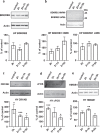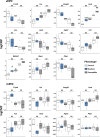The bradykinin system in stress and anxiety in humans and mice
- PMID: 31857655
- PMCID: PMC6923437
- DOI: 10.1038/s41598-019-55947-5
The bradykinin system in stress and anxiety in humans and mice
Abstract
Pharmacological research in mice and human genetic analyses suggest that the kallikrein-kinin system (KKS) may regulate anxiety. We examined the role of the KKS in anxiety and stress in both species. In human genetic association analysis, variants in genes for the bradykinin precursor (KNG1) and the bradykinin receptors (BDKRB1 and BDKRB2) were associated with anxiety disorders (p < 0.05). In mice, however, neither acute nor chronic stress affected B1 receptor gene or protein expression, and B1 receptor antagonists had no effect on anxiety tests measuring approach-avoidance conflict. We thus focused on the B2 receptor and found that mice injected with the B2 antagonist WIN 64338 had lowered levels of a physiological anxiety measure, the stress-induced hyperthermia (SIH), vs controls. In the brown adipose tissue, a major thermoregulator, WIN 64338 increased expression of the mitochondrial regulator Pgc1a and the bradykinin precursor gene Kng2 was upregulated after cold stress. Our data suggests that the bradykinin system modulates a variety of stress responses through B2 receptor-mediated effects, but systemic antagonists of the B2 receptor were not anxiolytic in mice. Genetic variants in the bradykinin receptor genes may predispose to anxiety disorders in humans by affecting their function.
Conflict of interest statement
The authors declare no competing interests.
Figures






References
-
- Werle E, Berek U. Zur Kenntnis das Kallikreins. Angew Chem. 1948;60:A53.
Publication types
MeSH terms
Substances
LinkOut - more resources
Full Text Sources
Medical
Molecular Biology Databases
Miscellaneous

